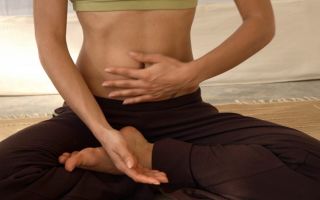Content
- 1 Types of breathing
- 2 What is diaphragmatic breathing
- 3 Benefits of abdominal breathing
- 4 Recommendations and preparation
- 5 Technique for performing diaphragmatic breathing
- 6 Exercises to develop diaphragmatic breathing
- 7 Belly breathing for weight loss
- 8 Contraindications to exercise
- 9 Conclusion
- 10 Reviews of those who have lost weight
In the hustle and bustle of everyday life, not everyone thinks that you can breathe in different ways: with benefit or harm to health - belly or chest. What are the features, benefits and harms of diaphragmatic breathing in the stomach, its difference from breathing with the chest and how to make the natural physiological process become curative for the body, you should learn in detail.
Types of breathing
All breathing methods can be divided into three main types:
- Clavicular, or upper thoracic.
This method of breathing lifts the shoulders and juts out the ribs. It is often characteristic of people with low levels of physical activity and smokers. The reason for this is the wrong lifestyle: working in a sitting position, lack of sports or stressful situations. Moreover, it is the harm of upper breathing that can eventually manifest itself with diseases of the internal organs and problems of the digestive system, as well as a decrease in the level of stress resistance of the body.

- Thoracic, or intercostal.
During this mode of breathing, the ribcage tends to rise and expand when the abdomen, shoulders, and collarbones remain in place. This means that the central part of the lungs is involved in the respiratory process. This method of breathing is more efficient, but it still limits the movement of the abdominal muscles. It is inherent in middle-aged men and women with a normal physique.
- Abdominal, or diaphragmatic.
With this breathing, the wall of the abdomen protrudes forward - due to the pressure of the diaphragm. Let's consider this technique and its properties.
What is diaphragmatic breathing
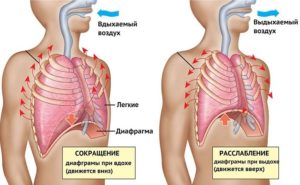
In diaphragmatic breathing, the main working organ is the muscle that separates the chest cavity from the abdominal cavity. This muscular septum tends to contract and fall when inhaling, as a result of which the abdomen relaxes and protrudes forward. During exhalation, the diaphragm, on the other hand, rises in the form of a dome and pushes air out of the lungs. The diaphragmatic method is considered the most natural and useful, because the body spends a minimum of effort to implement it.
The benefit of abdominal breathing is that it is during its use that the body is maximally enriched with oxygen (due to the fact that almost the entire useful volume of the lungs is involved), which minimizes the harm of oxygen starvation.
Benefits of abdominal breathing

The effectiveness of the diaphragmatic breathing method for the work of the whole organism has been proven, primarily due to the elimination of psychosomatic blocks.
With the chronic action of stress factors in the modern world in humans, due to constant muscle tension, including the abdomen and pelvis, a so-called muscle corset is formed, a source of psychosomatic problems. By relaxing the abdomen, mental blockages are eliminated.
Abdominal breathing practically does not harm the body, but its benefits can hardly be overestimated, since it:
- promotes fat burning: this is its beneficial property for weight loss;
- due to the saturation of blood with oxygen, it improves the functioning of the cardiovascular system;
- enhances ventilation of the lungs, since it involves almost all of their volume;
- benefits the speech apparatus, freeing up its work;
- improves the functioning of internal organs - due to their massage with the diaphragm;
- has a beneficial effect on the intestines, helping to get rid of constipation, bloating and other problems;
- has a special benefit for women: with the help of high-quality belly breathing, you can improve the condition of the skin of the face, reduce the number of wrinkles and various inflammatory processes.
More details about the features and benefits of abdominal breathing - in the video:
Recommendations and preparation
The best time to perform diaphragmatic breathing is in the evening, as this technique has a deep relaxing effect.
When doing beneficial breathing exercises, it is advisable to be in a quiet and calm place where no one can distract or interfere.
For overweight people, the beneficial diaphragmatic method can be a little more difficult because it is more difficult for them to relax the muscles during exercise.
The first 6 workouts should be performed approximately 30 minutes each.
After the first lesson, there may be unpleasant painful sensations in the diaphragm area during breathing or physical activity, but you should not worry: they are not harmful and soon disappear.
You can prepare yourself for training using the walking technique:
- the first 3 days while walking, you need to inhale air every 2 steps, and exhale every next 3 steps;
- from day 4, every one inhalation also falls on 2 steps, and exhalation - on the next 4.
The benefits of this technique will also work directly during the main training period, due to its property of ensuring that the diaphragm is adjusted to the correct breathing rhythm.
Technique for performing diaphragmatic breathing
Correct diaphragmatic breathing technique should train the tension of the abdominal muscles, including those located below the navel.
It will be useful to teach the muscle to relax voluntarily: in this state, through deepening and alignment of breathing, it tends to normalize blood circulation in the solar plexus, reduce anxiety and restore sleep.
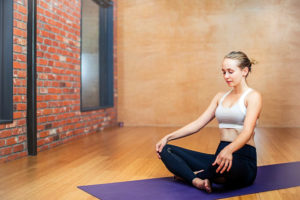
Before starting the exercises, you need to properly adjust your breathing, following a simple technique:
- For a start, it's best to wear comfortable clothes that don't restrict your breathing.
- Lie or sit on the mat and relax as much as possible.
- Examine the entire body from head to toe with the mind's eye.
- Then focus on the muscles involved in the breathing process, monitoring their relaxation during exhalation. It is best to keep your eyes closed.
- Inhale air very slowly.
- Try to breathe so that the chest does not rise while the lungs are filled with air.
- The exhalation should be done more slowly than the inhalation. In this case, the abdomen should be smoothly retracted.
- Repeating this technique will be beneficial every day for 5 minutes, gradually increasing its duration.
Ideally, you need to achieve a state of control of the work of the diaphragmatic muscle, through the maximum sensation and understanding of its work in the complex of the entire respiratory process.
The beneficial properties of diaphragmatic training are maximized when the ratio of inhalation and exhalation is 1: 4.
For beginners, it is enough to perform 12-15 cycles per minute.
The benefits increase with a gradual decrease in the frequency of cycles: in trained people, it drops to 3 - 6 per minute. This gives the body the opportunity to increase the content of carbon dioxide in the blood, the beneficial properties of which are manifested in strengthening all organs and systems.
After mastering the basics of diaphragmatic breathing, you can proceed directly to the exercises themselves.
Exercises to develop diaphragmatic breathing
Diaphragmatic breathing retains its beneficial properties when performed in different body positions. For a training course, depending on the stage and level of training, it is useful to choose the most suitable technique for yourself.
Let's consider the main ones.
On the back
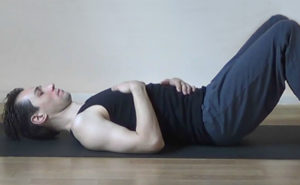
Very suitable for beginners: it is easier to control the entire breathing process in this position.
- Lie on your back with your legs bent at the knees and try to relax all the muscles of the body as much as possible.
- For ease of implementation, it will be useful to place your left hand on your chest, and your right hand on your stomach: this way you can better control the rhythm of breathing.
- In order for diaphragmatic breathing to be correct, the position of the right hand is monitored: it must remain motionless, while the left rises with the stomach on inhalation and descends on exhalation.
- The inhalation should be deep and inflate. The exhalation should be done slowly through the nose, pulling the abdominal wall towards the spine.
Sitting position
The benefits of a sitting position help - in a deeper study of breathing in the abdomen.
You should take any sitting position: in a lotus, on a chair. The main condition: the knees should be at the level of the pelvis.
The principle is the same:
- Close your eyes and relax as much as possible.
- The abdomen should contract on exhalation, relax and only then inflate on inhalation.
- Over time, the amplitude of the abdomen during inhalation and exhalation should become more natural: squeezing and inflation should go on by itself, not completely.
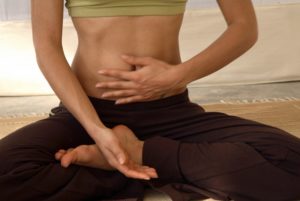
It is recommended to perform this exercise for 20 to 25 minutes.
Dog breath
With this technique, it is helpful to remember how the dog breathes.
To imitate such breathing, you need:
- Get on all fours, open your mouth and relax your abdominal muscles.
- Now you need to turn on dog breathing: quickened breaths and exhalations. This position will allow you to better feel the diaphragm and lungs.
Gradually bring breathing to 5 - 7 minutes.
Complicated sitting option:
- The pose is standard, semi-lotus or at the edge of a chair, with the spine straight.
- Inhales and exhalations should be sharp and frequent, multi-stage: through the nose - three inhalations, through the mouth with a tube - three exhalations.
- At the same time, the abdomen must be pulled up to the spine.
Complicated version with cargo
It is a modified lying exercise. Amplification of utility will provide a load: it may be the most ordinary book.
- You need to take a lying position, put the book on your stomach.
- The inhalation-exhalation technique is standard for diaphragmatic exercises, performed in such a way that the book moves up and down.
It will be useful to bring the execution up to 15 - 20 minutes.
Belly breathing for weight loss

Breathing with the diaphragm has the ability to effectively affect the body, contributing to both its recovery and the burning of fat in the body, without causing harm. A beautiful and flat belly can be obtained not necessarily by strength training.
Believe it or not, diaphragmatic breathing competes successfully with fitness training for its beneficial properties. During running or any other physical activity, oxygen is much more easily distributed throughout the body, thereby burning fat deposits. The diaphragmatic breathing technique allows for a better distribution of oxygen throughout the body in a static version of training. At the same time, the weight goes away smoothly and evenly.
It is important to learn how to breathe correctly by changing chest breathing to abdominal breathing. As a result, the abdominal muscles involved give a massage to the internal organs and launch a source of hidden energy in the body. The beneficial result is the burning of fat stores in the body.
The beneficial properties of diaphragmatic breathing are also considered to bring blood pressure back to normal and normalize metabolism.
To remove fat deposits in the abdominal area, you must practice the following diaphragmatic exercises:
- While inhaling, slightly inflate (round) the stomach, and on exhalation, pull it inward, pushing out all the rest of the air. It is recommended to practice this technique regularly after waking up.
- Lie on your back, bend your knees, relax deeply and inhale as deeply as possible, while drawing in your stomach. Then exhale: the stomach must be inflated. You need to connect your legs to the exercise: taking a breath, you need to raise them up, as when you swing the press. Thus, the abdominal muscles contract. In total, you need to do about 10 - 15 approaches.
- Take a supine position, place your arms along the body. Perform quick breaths in and out for 10 seconds. Then you need to draw in your stomach and slowly raise your legs perpendicular to the floor. Clasp your legs with your hands and pull towards you. In this case, the buttocks should not come off the floor. You need to stay in this position for 10 seconds, then return to the starting position and relax the muscles. It is recommended to do about 4 - 6 approaches at a time.
- Sit on a chair, straighten your back and bend your knees at a 90 degree angle. Take a deep breath in your stomach, alternately contracting and relaxing your abdominal muscles. You need to start with 10 approaches, gradually increasing their number. On average, it is recommended to perform 30 approaches at a time.
- You need to stand up straight with your feet shoulder-width apart. Take a slow breath, while raising your hands up, and then, carrying out the same slow exhalation, lower them back. Repeat the exercise 5-10 times.
Contraindications to exercise
Despite all the useful properties of the technique, diaphragmatic breathing has its own contraindications for implementation. One must always remember that excessive loads (including breathing exercises) tend to give both a negative effect on well-being and harm the work of the whole organism as a whole. All proposed diaphragmatic exercises must be performed in a system with the support of an instructor.
In the initial period of the practice of diaphragmatic breathing, dizziness or fainting may be observed - the reason for this is hyperventilation of the lungs.
You should not perform diaphragmatic gymnastics in the presence of individual contraindications to the use of this technique.
It is strictly forbidden to use the diaphragmatic breathing technique for people suffering from hypertension or other diseases that cause an increase in blood pressure.
It is also advisable to consult a doctor before performing this type of exercise.
Conclusion
The benefits and harms of diaphragmatic breathing continue to be studied by specialists. However, to date, many useful properties of this breathing technique have been discovered - starting with the normalization of the functioning of the body systems and ending with an increase in the quality of life in general. At the same time, diaphragmatic breathing should be practiced with caution, feeling the measure: excessive load can harm the body.

